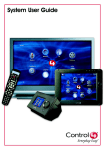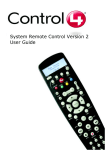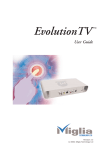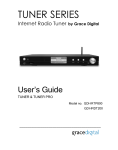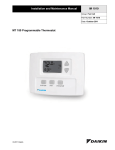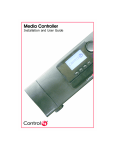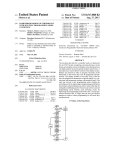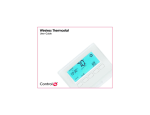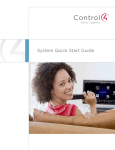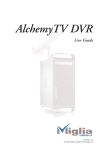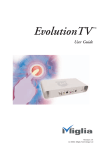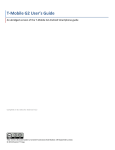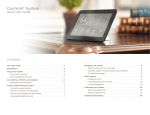Download Control4 RCZ-SRC2-B System information
Transcript
Disclaimer Control4® makes no representations or warranties with respect to this publication, and specifically disclaims any express or implied warranties of merchantability or fitness for any particular purpose. Control4 reserves the right to make changes to any and all parts of this publication at any time, without any obligation to notify any person or entity of such changes. Trademarks Control4 and the Control4 logo are registered trademarks of Control4 Corporation. Other product and company names mentioned in this document may be the trademarks or registered trademarks of their respective owners. Legal Notice Fraunhofer IIS and Thomson. MPEG Layer-3 audio coding technology licensed from Fraunhofer IIS and Thomson. Supply of this product does not convey a license nor imply any right to distribute content created with this product in revenue-generating broadcast systems (terrestrial, satellite, cable, and /or other distribution channels), streaming applications (via Internet, intranets, and/or other networks), other content distribution systems (pay-audio or audio-on-demand applications, and the like) or on physical media (compact discs, digital versatile discs, semiconductor chips, hard drives, memory cards, and the like). An independent license for such use is required. For details, visit http://mp3licensing.com. Decisionmark is the service provider of analog and digital TV off-air cable and satellite channel list. Radio Locator is the service provider of AM/FM channel list. © 2005-2008 All Media Guide, LLC provides music and video recognition technology that provides cover art and related text that enriches the Control4 user interfaces. Copyright Copyright © 2004-2008 Control4. All rights reserved. No part of this publication may be reproduced, photocopied, stored on a retrieval system, or transmitted without the express written consent of the publisher. Contact Information Control4 Corporation 11734 S. Election Road Salt Lake City, UT 84020 USA http://www.control4.com Part Number: 200-00001 Rev C Contents Chapter 1 Getting Started .............................................. 1 System Overview ................................... 1 Chapter 2 Interfaces Overview....................................... 3 Interface Devices ................................... 3 System Remote Control.................... 3 On-Screen Navigator ........................ 4 Touch Screens.................................. 4 LCD Keypad ..................................... 5 2-, 3-, and 6-Button Keypads............ 5 4Sight Services—Web Navigator ..... 5 On-Screen Navigator Basics ................. 6 Touch Screen Basics ............................. 7 Main Menu Access ........................... 7 Shortcut Buttons and Programmable Buttons.............................................. 8 LCD Keypad Basics ............................... 9 About the LCD Keypad ..................... 9 System Remote Control Basics ........... 10 About System Remote Control RCZ-SRC2-B .................................. 10 Remote Control Modes................... 11 Remote Control Features ............... 11 Set Preferences for Remote's LCD 13 View Part Number or MAC Address13 Install and Maintain Batteries.......... 14 Internet Services Basics ...................... 15 Chapter 3 System Activities ......................................... 17 Setting Up Your my.control4.com Account................................................ 17 Registering Your Controller ................. 17 Playing the Radio................................. 18 iii About the Radio Options................. 19 Play a Station.................................. 19 Control a Tuner............................... 19 Playing Music....................................... 21 About the Music Options................. 21 Now Playing Display ....................... 32 Now Playing Dashboard ................. 32 Play Music (Create a Now Playing Queue)............................................ 33 Edit the Now Playing Queue........... 36 Save the Now Playing Queue as a Control4 Playlist.............................. 38 Play a Saved Playlist ...................... 40 Play a CD Stored in a Changer ...... 41 Play a CD Loaded in a CD Player .. 42 Add a CD to the CD Catalog using a CD Changer ....................... 42 Edit a Digital Playlist ....................... 43 Play Music from an iPod ................. 43 Use Zones ...................................... 44 Listen to Music from Rhapsody ...... 45 Watching TV ........................................ 71 Change Channels ........................... 72 Use a Video Wall (10.5" Touch Screens Only) ................................. 73 Playing a Movie ................................... 74 Play a Video Stored in a Changer .. 74 Play a Video Loaded in a Standard DVD Player or VCR ........................ 75 Edit DVD Information ..................... 75 Add a DVD to the DVD Catalog...... 75 Controlling Comfort .............................. 76 Control Ceiling Fans, Blinds, and Fireplaces ....................................... 76 Control Wireless Thermostat .......... 77 Program the Thermostat................. 79 Changing Locations ............................. 82 iv Controlling Lighting .............................. 83 Access the Lighting Options ........... 83 Control Your Lights ......................... 83 Create a Lighting Scene ................. 83 Activate a Lighting Scene ............... 84 Monitoring the House Security............. 85 View Contact Switches or Relay..... 85 Arm or Disarm Security Panels....... 85 Use Security Cameras.................... 86 Adjusting Pool Settings ........................ 86 Pool Control Basics ........................ 86 Adding or Hiding Relays ................. 87 Changing System Information ............. 87 Access the Info Screen................... 87 Connect to a Director...................... 89 View or Change Network Settings .. 89 Allow Your Dealer to Remotely Access Your System....................... 91 Set Screen Saver Options .............. 91 Set Default Location ....................... 91 Enable or Disable Viewing Options 92 Using Control4 Internet Services ......... 93 Access Web Navigator ................... 93 View Entire System at a Glance ..... 94 View or Change Lighting................. 94 Check or Change Security Settings 95 View or Change Thermostat ........... 96 View Sensors or Motors.................. 97 Setting Up a Custom Screen Saver ..... 98 Setting Up a Wakeup Scene................ 99 Using Additional Custom Options ...... 100 Announcement Agents ................. 100 Customizeable Buttons................. 100 Chapter 4 Frequently Asked Questions ..................... 101 v vi CHAPTER 1 Getting Started Welcome to your Control4 home! Life just got much easier. We hope that you are excited to learn how to use your new system. We designed the system to be as easy to use as possible, so this won’t take long. We don’t want this manual to bore you, but we do want to give you all the information you need to have the best experience possible with your new system. This manual guides you through the most important aspects of your system. It quickly introduces you to the different features and explains how to use the different interfaces (which include in-wall, table-top, and hand-held remote controls). After that, you are welcome to throw this guide away or hold on to it (in case you want to look up a specific topic in the future). If you lose this manual, you can always get a copy of it on our Web site at www.control4.com/products/documentation. If you have any questions, please contact your certified Control4 dealer. Enjoy! The Control4 Team System Overview Let’s get started. First, it helps to understand some basics about your Control4 system. 1. Control4 is a room-based control system. The interfaces are set to control one room at a time (unless you choose to control several rooms as a group). So, while most interfaces are already set to their installed room, it doesn’t hurt to remember that if nothing happens when you try to turn off the lights or turn on the music, your interface may be set to a different room in the house. (That’s when you hear the yelling from another room.) All interfaces 1 show the currently selected room, so you can easily check which room you are working with. 2. Control4 interfaces manage up to eight sub-systems per room. Depending on your setup, the menu options may differ from room to room, with unavailable options dimmed. For instance, if you’re in a room with no music available, the music icon will be dimmed out. Here’s a breakdown on everything you can do with a Control4 system: Radio—Browse available radio stations, including AM, FM, XM, satellite, and cable stations. Music—Browse digital music integrated into your Control4 system by artist, genre, playlist, or album cover art. Additional music sources such as iPorts or CD players are incorporated into the Music sub-menu if they are present in your system. TV—Browse available TV channels (UHF/VHF, cable, or satellite). Videos—Browse available videos in your DVD changer or select a video source (DVD player, VCR, etc.) to control. Comfort—Adjust the temperature in your home and control ceiling fans, blinds, fireplaces, and other home settings. Also includes access to your Control4 wakeup scene to set an alarm clock for any room in your home. Lights—Control the lights in your current room and access all lighting scenes in your home. House—Switch between rooms and access securityrelated devices in your home. Info—Display system information such as network status, screensavers, and other options. 2 CHAPTER 2 Interfaces Overview A user interface is any Control4 device that you use to control your installed systems, such as a remote or a touch screen. Below is a breakdown of all of the interface devices you may have in your Control4 system: Interface Devices System Remote Control The Control4 System Remote Control, the standard control device for most Control4 systems, works like a universal remote on steroids. From one remote, you can control your home theater equipment, your lights, your music, your room temperature, and any other installed sub-system. You can also use it to browse sub-system menus on a television or monitor screen (on-screen navigator) or in its display window (LCD navigator). NOTE: The information in this guide pertains to the V2 Remote Control. For information on using any other Control4 remote control, refer to your remote control manual. 3 On-Screen Navigator The Control4 On-Screen Navigator, accessed with the Control4 System Remote, uses a graphical sub-system menu that you can see on a connected TV or monitor. Through the navigator, you can access every aspect of your Control4 system—from music and movies to lighting and temperature control. Touch Screens Control4 Touch Screens come in a variety of shapes and sizes and most can be installed in the wall or sit on your desktop. Every Control4 Touch Screen can control your entire Control4 system. 4 LCD Keypad The Control4 LCD Keypad offers an affordable way to add complete control to any room in your house. Instead of a touch screen, simple buttons and a scroll wheel help you navigate through the sub-system menus. This interface can also control all devices connected to your Control4 system. 2-, 3-, and 6-Button Keypads Control4 keypads include customizable buttons that can be programmed for any custom scenario. Most Control4 customers use them to control different lighting scenes in their home (such as turning off all of the downstairs lights), or playing a certain playlist in their room. 4Sight Services—Web Navigator Forgot to turn off the lights before heading to work? 4Sight Internet Services give you the ability to monitor and control your home from any Web browser in the world. 5 On-Screen Navigator Basics Ready to get started? The on-screen navigator works via any TV you’ve connected to the Control4 systems. Press the button on the system remote to open your on-screen navigator menu, which gives you access to your installed sub-systems. Now you can start exploring your sub-systems, starting with the main menu. From the main menu, access controls for any sub-system (Radio, Music, TV, Videos, Comfort, or Lights) or view house status or system Information. For example, tired of Barry Manilow? Using the system remote’s arrow keys, move to the music sub-system and press the control’s Select button. Now you can see your Music sub-system’s option bar. But wait. We’re not done. If you see an arrow in the upper right corner of an option bar, that means you have more options. The arrow keys also help you navigate through a sub-system’s additional options. NOTE: You can always press the button to get back to the main menu. In case you get stuck, you can always find your way home. NOTE: Cancel will take you back to the previous menu. 6 Touch Screen Basics Control4 Touch Screens come in different shapes and size, but each features a similar menu, making it easy to use multiple touch screens. The Control4 10.5” Touch Screen, 7” Touch Screen, and Mini Touch Screen provide menu options that are nearly identical to the Control4 On-Screen Navigator options. However, these devices differ slightly in the way the pages are laid out. Main Menu Access 1. Tap the screen or hold and release the power button (10.5” wireless model only). 2. If a screen other than the main menu is displayed, press the main menu icon. Volume Control: Adjust the volume. Lighting Control: Access light controls and lighting scenes. 7 Shortcut Buttons and Programmable Buttons The 7” touch screen also has four buttons (just below the screen) that can be custom programmed by your installer. If your installer has programmed the buttons, write their functions on the list below. NOTE: You can always find the custom buttons programmed into your system under the House menu on any Control4 interface. Custom Buttons Programmed by Installer: A: ______________________________________ B: ______________________________________ C: ______________________________________ D: ______________________________________ 8 LCD Keypad Basics The LCD keypad uses a combination of hard button presses and the scroll wheel to navigate the sub-systems. About the LCD Keypad 1. Selection Buttons: Selects the corresponding option on the screen. 2. Selection Dial: Scrolls through menus, acts as a selection button, and sets room volume. 3. Shortcut Button: Programmable, choose a specific action like turning off the lights, starting a playlist, or arming the Security sub-system. NOTE: If you have a problem viewing a screen or if the screen displays "connecting..." or “no location,” contact your Control4 dealer or visit my.Control4.com for troubleshooting options. 9 System Remote Control Basics Now, instead of hunting for five different remotes, you can rely on the Control4 System Remote Control to manage your home. Besides replacing multiple audio-video remotes, this device controls all supported sub-systems, including lights, music, and temperature. About System Remote Control RCZ-SRC2-B System Remote Control Model #RCZSRC2-B can be divided into these sections: 1 1. LCD screen and button and Off button 2. Contol4 button and sub-system buttons 3. navigation buttons 4. device control buttons 5. keypad Once the system setup is complete, the remote control responds to each buttonpress in a different way—depending on: 2 3 4 mode of remote control current location devices available in the current location when the button is pressed if the button has been programmed for a custom function 10 5 Remote Control Modes The remote control modes are On-Screen Navigator mode: Press the button to turn on the TV interface and bring up the navigator menu. LCD Navigator mode: Use the system remote’s LCD window to manage your installed Control4 sub-systems by pressing the LCD button, which displays a menu in the LCD. Device-Control mode: Press the device-specific button to control things like your DVD player or TV. Remote Control Features Below are explanations of some of the remote control features. LCD (liquid crystal display)—Provides information related to system activity. LCD button—Changes the remote mode to LCD Navigator mode, displaying the menu in the LCD. Off button—Turns off all A/V devices in the current room (TV, DVD players, etc.). button—Puts the remote in on-screen mode and displays the on-screen menu for the current location. Sub-System Buttons as Shortcuts From either the on-screen or LCD navigator mode you can use the Radio, Music, TV, or Videos button to access these options. One-Touch Action: If the devices in the current room are off or the remote is being used in Device-Control mode, the Radio, Music, TV, and Videos buttons function as Quick Access buttons. First button press: Turns on the last source used for that sub-system. For example, you may press the Videos button once to turn on the DVD player. 11 Subsequent button presses, prior to LCD time-out, toggle through additional sources displayed in the LCD and turns them on. For example, you may press the Videos button again to toggle to the VCR and turn it on. Programmable Buttons The following buttons can be custom programmed by your installer: Sub-System Buttons Programmed by Installer: A: ______________________________________ B: ______________________________________ C: ______________________________________ D: ______________________________________ Keypad * ______________________________________ # ______________________________________ If the devices in the current room are off, pressing one of these buttons will run the custom program assigned to that button. NOTE: You can always find the custom buttons programmed into your system under the House menu on any Control4 interface. If none of your buttons are programmed, you’ll only wake up the LCD and display the name of the current room. 12 Set Preferences for Remote's LCD 1. Press the LCD button. 2. Select Info > Config to set LCD display preferences or view the battery level: Set Brightness: Use the arrows to move slider bar to brighten or dim display. Set Contrast: Use the arrows to move slider bar to increase or decrease contrast. Set LCD Backlight: Use the arrows to choose a Backlight option: On (comes on with every button-press) Off (never comes on) LCD Navigator Only (only comes on when the remote control's LCD menu is used) View current battery level: Battery level is displayed. View Part Number or MAC Address To view the remote control part number and MAC address: 1. Choose Info > About to view the remote control part number and MAC address. 2. Press Cancel to exit the LCD navigator. NOTE: You can access the preferences view on any Control4 interface to adjust brightness, screensavers, backlight options, etc. 13 Install and Maintain Batteries Use and Care Tips AAA + - AAA - Install the four AAA batteries (included with the product) into the back of the device. Ensure that you insert them into the remote control according to the diagram provided in the battery compartment (with the + and - terminals aligned correctly). + - Install Batteries Remove batteries from the remote control if it is not expected to be in use for several months. AAA AAA Extreme temperatures reduce battery performance. Avoid putting the remote control in very warm places. + + Keep battery contacts and compartment clean. Replacement Safety Rules CAUTION! To prevent battery shorting, leakage or rupture: Use typical AAA Alkaline batteries only in the remote control. Do not mix battery types, such as Alkaline and rechargeable NiMH batteries. Do not attempt to recharge a battery unless the battery is specifically marked “rechargeable.” Never dispose of batteries in a fire. 14 Internet Services Basics Control4 offers two levels of Internet services: my.Control4.com: a free service provided upon system registration at my.control4.com. Registering at my.Control4.com: enables access to Control4’s online media configuration services for media identification and TV/radio channel configuration enables access to Rhapsody, a subscription-based online music service allows your dealer to remotely access your system for configuration, maintenance, and troubleshooting through a service connection 4Sight: a subscription-based service with an annual renewal fee. See your dealer for details. A 4Sight subscription: enables Web Navigator enables the email agent For information on setting up your my.control4.com account, see “Setting Up Your my.control4.com Account” on page 17. 15 16 CHAPTER 3 System Activities In this chapter, you’ll learn about some typical system activities. NOTE: To use all media services, including Rhapsody, you need to register your free my.control4.com account. Setting Up Your my.control4.com Account A my.control4.com account is required to use media services. To set up your free my.Control4.com account: 1. Visit http://my.Control4.com. 2. Choose Create Account. 3. Fill out the registration according to the instructions on the page. 4. Select Submit Registration to create your account. Registering Your Controller Immediately after you have set up your my.Control4.com account, you will be asked if you would like to complete your registration by registering your controller. To do this: 1. Select Yes. 2. From your navigator, choose Info. 3. Select Remote Access. 4. Select the text box in Enter Code. 5. A keyboard pops up. Enter your code. 6. When you are finished, select Done. 7. Choose Activate. 17 Or you can register your controller at any time by logging into your my.control4.com account and selecting My Account > Controller Registration. Once you have set up remote access, you can enter your username and password to securely log in to your home from any internet connection in the world through the Web Navigator interface. This allows you to monitor and control the lights, change the temperature so the house is warm when you get home, or check to see if any doors or windows were accidentally left open. See “Using Control4 Internet Services” on page 93 for more information. Playing the Radio Use any Control4 interface to choose Radio and access your radio options. 18 About the Radio Options The Radio options provide access to a Stations screen and any radio device you have added to this location in the system, such as a receiver or tuner. NOTE: For quick access to volume controls, use the Volume Quick-Control button. Stations Screen—Displays all available radio stations on your system. Tuners and Other Radio Devices—Displays controls for AM, FM, XM, satellite, cable, or radio broadcast. Play a Station 1. On the Radio screen, select Stations (usually selected by default). 2. View the list of available radio stations for the selected tuner (such as XM, FM, or AM). 3. Change tuners (XM, FM, or AM) or scroll through the list as needed. 4. Select a station to turn on the broadcast. Control a Tuner NOTE: Control options for your radio system will depend on what your device supports and may also display an intermediary device, like a receiver. On-Screen Navigator From the Radio screen, choose a tuner device button. After selecting the tuner, you will be returned to the main screen on your on-screen navigator (the selected tuner displays in the bottom right-hand corner of the screen). 19 Control the tuner using the device control buttons on the remote control. If you have a list of favorite channels loaded, you can select one of these channels by choosing Radio > Channels and picking a channel. Touch Screens From the Radio screen, choose a tuner device button, which, depending on what your tuner supports, may include: Scan all stations, tune up and down, or choose a specific station. Control volume. System Remote Control Under Radio > Stations, select a station (highlight and press Select) if you have a favorites list loaded. Or enter the number of a station, or use preprogrammed buttons to select a favorite station. LCD Keypad Highlight a radio selection and press the Select Dial. When you select a device, controls are displayed on the screen. For screens such as the Stations option, scroll up or down to highlight your choice and press the Select Dial. 20 Playing Music Play either saved digital music or music from your online Rhapsody account using your Control4 system. NOTE: To use Rhapsody, you must add an account using your touch screen or on-screen navigator. For Rhapsody-specific instructions, see the tasks beginning on pg. 46. About the Music Options On the main Music menu, you will see your music sources and zones displayed across the top of the screen. Following are the default settings: 21 On-Screen Navigator and Touch Screen Digital Music (default): Displays main music options. My Library: Your saved artists, albums, genres, channels (Rhapsody only), and playlists Rhapsody: Access to millions of tracks in Rhapsody’s online music database through your Rhapsody account (if you do not have an account, you can sign up for a free trial) Queue: The music queue for Now Playing Settings: Configuration settings for digital music Zones: Displays currently active zones with a list of rooms in each session. Allows you to add or remove rooms from zones and control volume for an entire zone or an individual room. Now Playing Display: Shows current track, artists, and album, which you can select for more information. Now Playing Dashboard (bottom of screen): Shows current track, displays skip forward, skip back, play, pause, and clear buttons. Selecting playback controls will bring up the Now Playing Queue. LCD Keypad and Remote Control Rhapsody: Access to millions of tracks in Rhapsody’s online music database through your Rhapsody account (if you do not have an account, you can sign up for a free trial.) My Library: Your saved artists, albums, genres, channels (Rhapsody only), and playlists Browse CDs: CDs in CD players or CD/DVD changers in your system Now Playing: The music queue for Now Playing Playlists: Your saved playlists Zones: Displays currently active zones with a list of rooms in each session. Allows you to add or remove rooms from zones and control volume for an entire zone or an individual room. Settings: Configuration settings for digital music Digital Audio: Displays controls for your digital music NOTE: If your system includes CD players or CD/DVD changers, these will also be displayed as sources in this area. NOTE: Selecting the Control4 icon returns you to the Now Playing view (the main Digital Music screen). 22 Digital Music: My Library My Library contains both your Rhapsody library and your saved digital music. My Library contains the following menus: On-Screen Navigator and Touch Screen My Artists: A list of all the artists in your saved music My Albums: A list of all your saved albums My Genres: A list of all the genres of your saved albums My Channels: Your saved channels My Playlists: Your saved playlists (digital music or Rhapsody) LCD Keypad and Remote Control My Rhapsody Library: Your saved Rhapsody music (Rhapsody only) Albums: A list of all your saved albums Artists: A list of all the artists in your saved music Albums By Genre: A list of all the genres of your saved albums Artists By Genre: A list of all the genres of your saved artists 23 NOTE: The Control4 icon indicates digital music files that are saved in your library. The Rhapsody icon indicates Rhapsody files that are accessible through your library. Digital Music: Rhapsody Rhapsody is a subscription-based music service that gives you unlimited access to a catalog of millions of full-length, CDquality tracks. You can listen to whatever you want, whenever you want, in any room of your house through your Control4 system. To browse Rhapsody, choose from the following menu options: On-Screen Navigator and Touch Screen 24 LCD Keypad and Remote Control Search Rhapsody Recommends Music Guide Music Guide Channel Guide Channel Guide Playlist Central Playlist Central My Account My Account NOTE: You can also select a song from Rhapsody Recommends (displayed next to the menu), a list of recommended music from Rhapsody based on your listening history. NOTE: To return to the main Rhapsody menu from a Rhapsody submenu, select the Rhapsody icon the Digital Music and Zones icons. beneath Search View search history or select from the following search options: Artist Keyword Track 25 Album Composer NOTE: Search is available through on-screen navigators and touch screens only. 26 Music Guide Select from the following menus: On-Screen Navigator and Touch Screen Charts: View Top Artists. Play Top Albums and Top Tracks. Genres: Select a genre to view available music within the genre. (After you select a genre, you can sort the available music in a variety of ways, including by subgenre.) New Releases: Play New Releases or add them to your library. Just Added: Play or add recently added music. Exclusives: Play exclusives or add them to your library. Staff Picks: Play staff picks or add them to your library. LCD Keypad and Remote Control Top Artists Top Albums Top Tracks Genres (After you select a genre, you can sort the available music in a variety of ways, including by subgenre.) New Releases Just Added Exclusives Staff Picks 27 Channel Guide Find Rhapsody channels using the Channel Guide. Top Channels: Play top channels. All Channels: Play or add any of the available Rhapsody channels to your library. Genres: Select a channel by genre. Playlist Central View available Rhapsody playlists. Top Playlists: Play Top Playlists. Recent Playlists: Play or add Recent Playlists (playlists recently added by Rhapsody or by other users). Genres: Select a genre to play or add playlists. Dynamic Playlists: Play or add Dynamic Playlists (playlists generated for you based on your listening history) to your library. 28 Featured Playlists: Play or add Featured Playlists. Select a playlist from the following categories (for on-screen navigators or touch screens, use the dropdown menu; the order of options is reversed for LCD keypad and remote control): Label Spotlights Single Artist Mixes Decade Mixes Theme/Holiday Mixes Celebrity Picks Genre Mixes Digital Music: Queue/Now Playing Under Queue, choose from the following options: Shuffle: Select the Shuffle option to shuffle the Now Playing list randomly each time you start the music. (This setting is persistent, meaning that the next time you start 29 up different music, it will still be in shuffle mode until you turn it off). Repeat: The Now Playing list will continue to play and repeat until you either clear the playlist or stop the playback. When Repeat and Shuffle are both selected, then the playlist will play every song in the list before shuffling the list and repeating any song in the list. Repeat and Shuffle activated together will also continue to play music until you clear the playlist or stop playback. Clear: Clear the Now Playing queue and stop music. Save as Playlist: Save the queue as a playlist. Edit list: Press this button to edit the Now Playing queue. You can reorder the tracks or select and remove individual tracks from the playlist. NOTE: To edit a playlist on an LCD keypad or remote control, select a song and then choose Play Now or Remove from Queue. Browse/Browse Library (LCD keypad or remote control only): Use shortcut to Browse/Browse Library view to add items to the Now Playing queue. 30 Digital Music: Settings Settings allows you to choose what happens when you select the play button. Choose from the following behaviors: Play now, Add to Queue, and Ask me. 31 Now Playing Display Select the artist or album to view more information. Now Playing Dashboard Selecting an artist, album, or track from your library creates a Now Playing queue. Selecting more music will add it to the queue. You can save your queue as a playlist at any time using any Control4 interface. The Now Playing Dashboard display at the bottom of on-screen navigators and touch screens. The Controls have the following four options: Play/pause Skip forward Skip back Stop (clears queue) NOTE: Selecting the Now Playing Controls section takes you to the a view of the Now Playing queue. 32 NOTE: You can use the system remote transport controls to control the music currently playing in a room. Play Music (Create a Now Playing Queue) Playing a digital album or track automatically creates a Now Playing queue. Selecting more items in the My Library list adds to the queue. To create a queue, follow the steps indicated for your navigator of choice. On-Screen Navigator and Touch Screen 1. From the Main menu, choose Music > Digital Music. Then select My Library 2. Choose one of the options below and browse to a list of albums, channels, or playlists: My Artists (default selection): My Albums 33 My Genres My Channels (Rhapsody only) My Playlists 34 3. Select Play to play an album, channel, or playlist. 4. From the pop-up screen that appears, select Play Now to immediately play your selection, Append to Queue to add your selection to the queue, or Cancel. NOTE: You can change the behavior of Play to always play now or always append music to the queue by changing the default selection under Settings. See “Digital Music: Settings”. 5. Or select an artist or album to select individual tracks to play. LCD Keypad and Remote Control 1. From the Main menu, choose Music. Then select My Library. 2. Choose one of the options below and browse to a list of albums, channels, or playlists: My Rhapsody Library Albums Artists Albums by Genre Artists by Genre 3. Select Play to play an album, channel, or playlist. 4. Select Play Now to immediately play your selection, Append to Queue to add your selection to the queue, or Cancel. NOTE: You can change the behavior of Play to always play now or always append music to the queue by changing the default selection under Settings. See “Digital Music: Settings”. 5. Or select an artist or album to select individual tracks to play. NOTE: The LCD keypad and the remote control show a music note next to the currently playing song. 35 Edit the Now Playing Queue You may want to edit the current queue to change the order of tracks played or to remove individual tracks from the queue. On-Screen Navigator andTouch Screen 1. From a touch screen or on-screen navigator: From the Main menu, choose Music > Digital Music > Queue. 2. Select Edit List. . . and use the following screen options to modify the list. [update the list below for the other devices] Select the up or down arrow to change a track’s order in the queue. Choose the delete button the queue 36 to remove a track from 3. Select Save Changes to save your changes to the list and exit, or choose Cancel to reject your changes and return to the previous screen. LCD Keypad and Remote Control 1. Choose Music > Now Playing > Queue. 2. Select a song in the queue. Choose Play Now or Remove from Queue. 3. Select Save Changes to save your changes to the list and exit, or choose Cancel to reject your changes and return to the previous screen. 37 Save the Now Playing Queue as a Control4 Playlist Control4 playlists save all tracks currently in the playlist (both locally stored and Rhapsody tracks). Control4 playlists are only accessible on your Control4 home network. NOTE: For touch screen or on-screen navigator only. 38 1. From the main Music menu, select Queue. 2. Choose Save as Playlist. . . 3. Select Control4 Playlist. 4. Name your playlist. 5. Select Done. 6. The playlist is saved and can be accessed by going to Music > Digital Music > My Library > My Playlists. 39 Play a Saved Playlist On-Screen Navigator and Touch Screen 1. 40 From the Main menu, choose Music > Digital Music > My Library > My Playlists. 2. Select the play button next to the playlist you wish to play. Remote Control LCD and LCD Keypad 1. From the Main menu, choose Music > Playlist/Playlists. 2. Scroll through the playlists. 3. Highlight a playlist and press the Select button. Play a CD Stored in a Changer To access a CD stored in a connected CD/DVD changer: 1. From the Main Menu, choose Music > Browse CD’s. 2. Choose a filter option or browse all albums to select an album or track to play. NOTE: After selecting an album, if you select a second album, it will not be queued to play after the first album but begin playing immediately. 41 Play a CD Loaded in a CD Player 1. Load CDs into your CD player connected to the Control4 system. 2. From the Main Menu, choose Music > CD Player. 3. Use the on-screen controls or the buttons on the remote control to control the CD player directly. Add a CD to the CD Catalog using a CD Changer NOTE: Your installer must have added at least one CD to your system or you will not be able to add music. If your system has at least one CD available in the Browse CDs music option, you can add additional CDs to your system using an on-screen navigator or a touch screen. 1. From the Main menu, choose Music. 2. Choose Browse CDs. 3. Choose Add. 4. In the list provided, choose the disc changer where the CD is loaded. 5. Select the slot the CD is loaded in. 6. When prompted by the screen, enter the album title or artist and select Search. The album will then be saved to your list and can be browsed. 7. Choose Save. NOTE: This can be done from a touch screen or on-screen device only. You cannot add a CD from an LCD keypad or a remote control. NOTE: You can also add CDs to your library and edit your library using the Easy Importer program or ComposerME. 42 Edit a Digital Playlist 1. Load the playlist into the Now Playing list. 2. To remove or edit the order of tracks, follow the instructions in “Edit the Now Playing Queue”. 3. To add tracks, add additional tracks to the Now Playing list. 4. Save the new list with the old name. Play Music from an iPod Music stored on an iPod can be accessed in two ways, depending on how your iPod was added to the system. iPod connected through USB port iPod connected through an iPort™ device (sold separately) iPods connected through a USB port are treated like any other music storage device. Once the music stored there is scanned into the system, you can access it from any interface device by choosing Music > Digital Music > My Library (or Music > My Library). iPods connected through an iPort™ device are handled a little differently: 1. After the iPort has been added to the system, play music from the iPod by accessing the iPort device found among your Music device options: Go to Music > iPort. 2. In the graphical navigators (on-screen navigators or touch screens) the iPort controls and options are a lot like those found on the iPod itself. In the list navigator screens (remote control LCD and LCD keypad), you can select the iPort device and then use the basic controls (Pause, Play, Next, Previous, FF, Rew). 43 Use Zones To view a list of all rooms in the home where music is currently playing or to add, remove, or control any room’s audio, select Zones from the Main music menu. When no music is playing in the entire system, only the No Session option is listed. When a zone is playing music, you can do the following: Join current room to a session by selecting a session name. Remove current room from a session. Select other rooms in your system to send music to. Control volume for or mute a zone or an individual room. 44 Listen to Music from Rhapsody Rhapsody is a subscription-based music service that gives you unlimited access to a catalog of millions of full-length, CD-quality tracks. You can listen to whatever you want, whenever you want, in any room of your house through your Control4 system. Control4 systems come with a free 30-day trial of Rhapsody. The following pages include instructions on how to access and use Rhapsody. Try Rhapsody with a Free 30-day Trial For a free Rhapsody trial account: 1. Choose Music > Rhapsody. 2. A screen will appear asking you whether you want to log in or create a free trial account. Select Free 30-day Trial. 3. You must agree to the user terms to activate your free trial account. 45 Create a Rhapsody Account To create a Rhapsody account: 1. From an Internet connection, go to http://www.control4.com/rhapsody/. 2. Select Join Now. 3. Follow the directions given. Once your account is set up, you may log into Rhapsody using your Control4 system. Log in to Rhapsody To log in to Rhapsody (you only need to enter your Rhapsody account information once): 46 1. From a touch screen or on-screen navigator, select Music > Rhapsody. 2. Choose Sign In. 3. Select the blank field beside User Name. A keyboard appears. 4. Enter your user name. 5. Select Done. 6. Select the blank field beside Password. A keyboard appears. 7. Enter your password. 8. Select Done. 9. Choose Login. Log out of Rhapsody It is only necessary to log out of Rhapsody if you want to stop using Rhapsody or want to switch user accounts. 1. From a touch screen or on-screen navigator, select Music > Rhapsody > My Account. 2. Choose Log Out. Play Music from Rhapsody (Create a Now Playing Queue from Rhapsody) 1. Choose Music > Rhapsody. 2. Browse to a channel, playlist, or album. Or choose Music > My Library and select a Rhapsody track that has been saved to your system. 3. Select an album or track. 4. Choose Play. 5. From the pop-up window that appears, select Play Now to play the selection immediately, Append to Queue to add it to the queue, or Cancel. 47 Search for Music in Rhapsody To search for music (on-screen navigators and touch screens only): 1. From the main Music menu, select Rhapsody. 2. Choose Search. 3. Under Search by, select a search category: Artist Keyword Track 48 Album Composer 49 50 4. Enter a search term. As you enter your search term, an automatic search will begin displaying results under Were you looking for. . . 5. If you see the result you want under Were you looking for. . . , select it. Otherwise, finish entering your search term and select Search. 6. Select an artist or composer to view or play albums and tracks or add the albums or tracks to your library. View Recent Search History in Rhapsody To view recent searches (on-screen navigators and touch screens only): 1. From the main Music menu, select Rhapsody. 2. Choose Search. 51 3. The recent search history is displayed. The results are sorted by Artist, Keyword, Track, Album, and Composer searches. 4. Use the scroll bar to view more searches by scrolling down. You can select one of the entries in search history to perform a search on the selected item. Create a Playlist Saving the tracks in the current queue as a Rhapsody playlist will create a new playlist in your Rhapsody library (accessible online, as well) that includes all of the Rhapsody tracks (no saved digital tracks) in the current queue. On-screen navigators or touch screens only: 1. 52 From the main Music menu, select Queue. 2. Choose Save as Playlist. (Press Cancel to return to the Queue screen.) 3. Select Rhapsody Playlist. (Press Cancel to return to the Save as Playlist screen.) 53 54 4. Name the Playlist. 5. Select Done. 6. The playlist is saved and can be accessed by going to Music > Digital Music > My Library > My Playlists. Play or Add a Playlist in Rhapsody 1. From the main Music menu, select Rhapsody. 2. Choose Playlist Central. 3. Select one of the following categories: Top Playlists (default selection) Recent Playlists Genres Dynamic Playlists 55 3.a Featured Playlists 4. Select the Play button or select next to the list you wish to play Add to save the playlist to My Playlists. NOTE: When viewing an album, select the artist’s name to view the artist’s available work. Add Music to a Rhapsody Playlist 1. 2. 3. To add music to a playlist, play the playlist. Add music to the Now Playing Queue. Save the updated list again with its old name. Edit a Rhapsody Playlist 56 1. 2. 3. 4. Play the playlist you wish to edit. 5. Select Save Changes. From the main Music menu, select Queue. Choose Edit List. . . Reorder songs using the up/down arrows delete using the delete button . or Delete a Rhapsody Playlist To delete a Rhapsody playlist (on-screen navigator or touch screen only): 1. From the main Music page, select My Library > My Playlists. 2. Select the delete button to delete. next to the playlist you want Play a Channel To play a channel: 1. From the main Music menu, select Rhapsody. 2. Select Channel Guide. 3. Choose from the following Top Channels: Play a top channel. All Channels: Play or add a channel to your library. 57 Genres: Play or add channels within a specific genre. Choose from Top Channels: Play top channels within the genre. All Channels: Play or add channels within the genre to your library. My Channels (on-screen navigator or touch screen only): Play or add a channel to your library. 4. 58 Select a channel and select the + button to add it to My Channels or select the button to play the channel. View Music Charts in Rhapsody To view music charts: 1. From the main Music menu, select Rhapsody. 2. Choose Music Guide. 59 3. From an on-screen navigator or touch screen: Select Charts. (This is the default selection in Music Guide.) For an LCD keypad, skip to step 4. 4. Choose from the following: Top Artists: View the top twenty-five artists. (Select an artist to view work by the artist.) Top Albums: Play or add the top twenty-five albums to your library. (Or select an album to play individual tracks.) Top Tracks: Play or add the top twenty-five tracks to your library. 60 View Genres in Rhapsody To view music by genre: 1. From the main Music menu, select Rhapsody. 2. Choose Music Guide. 61 62 3. Select Genres. 4. Choose from the displayed genres. (This will bring up a new screen.) 5. Play or add an album to your library. Use Artist View in Rhapsody To enter Artist view: 1. Select an artist (from search results, album view, Rhapsody lists, or Now Playing). 2. Choose from the following: Top Tracks (automatically selected): Play or add the artist’s top tracks. Top Albums: Play or add the artist’s top albums. All Albums: Play or add all albums by the artist. Artist Sampler: Play or add sample tracks by the artist. About the Artist: See a review of the artist. Artist Channel: Play or add the artist’s channel to your library. Related Artists: View related artists. 63 Use Album View 1. Select an album (from search results, artist information, Rhapsody lists, or Now Playing). 2. Choose from the following: Album Tracks Album Review Similar Albums Play New Releases from Rhapsody To view newly released albums: 64 1. From the main Music menu, select Rhapsody. 2. Choose Music Guide. 3. Select New Releases. 4. Play or add an album. Play Music Just Added to Rhapsody To view music recently added to Rhapsody: 1. From the main Music menu, select Rhapsody. 65 66 2. Choose Music Guide. 3. Select Just Added. 4. Play or add an album. Play Exclusives from Rhapsody To view music content exclusive to Rhapsody: 1. From the main Music menu, select Rhapsody. 67 68 2. Choose Music Guide. 3. Select Exclusives. 4. Play or add an album. Play Rhapsody Staff Picks To view Rhapsody Staff Picks: 1. From the main Music menu, select Rhapsody. 69 70 2. Choose Music Guide. 3. Select Staff Picks. 4. Play or add an album. Watching TV You can use any interface on the Control4 system to turn on and watch TV (although the System Remote is usually the easiest). screen—Lists all local or other broadcast channels, such as cable or satellite/ dish channels. TV Devices—Lists available TV devices, including local channels and cable/ satellite/dish channels, in your current location. 71 NOTE: If your system includes a Video Wall and a "center" room in your system, then your TV will include a Video Wall button, providing you with access to the Video Wall (from 10.5” touch screens only). NOTE: Press and hold the TV button on the System Remote to display the TV options on the monitor or TV. Change Channels You can change the TV channel a number of ways using the remote control: Press the or navigation button. Press the Channel + or - button. Enter a specific channel number on the keypad. Choose a channel from the list in the LCD. You can also change the channel from any touch screen by selecting Television, choosing the television you wish to control, and choosing a channel’s graphical button. 72 Use a Video Wall (10.5" Touch Screens Only) Your installer can create a Video Wall for you by installing multiple televisions on a single wall. You’ll never be bored again. You can watch more than one video source at a time. While you’ll only hear audio from one at a time, you can use the Digital Video Recorder (DVR) feature for all supported views. The system supports view swapping between televisions or monitors. To Use the Video Wall: 1. From the Main Menu on a 10.5” touch screen, choose TV > Video Wall. Figure 3-1. Video Wall 2. Press the Start button to start the television broadcasts on all TVs in your video wall and to activate the playback controls for your video wall. NOTE: The audio is only provided for the program shown on the center display. Figure 3-2. Video Wall Activated 73 3. Choose Instant Replay to catch any action you missed on either the left or right display. 4. Choose Swap to change your video source between displays, activating audio for any source shown in the center screen. Playing a Movie Play a Video Stored in a Changer To access a DVD stored in a connected DVD changer: 1. From the Main Menu, choose Videos. 2. From the options displayed, choose Browse/Browse Library or Cover Art (on-screen devices or touch screens only). 3. Select a movie. 4. Select the Play button. NOTE: Press and hold the Video button on the system remote to display the Video options on the monitor or TV. Browse/Browse Library The Control4 movie system makes it easy to find that perfect title. With your videos organized in five categories, you can debate which Russell Crowe flick fits your mood or find the perfect cartoon to calm the kids down. Movies/All Genre Director Actor Rating NOTE: You can use the keypad on the remote to quickly jump to movies in the list that begin with the corresponding letters on the keypad. 74 Cover Art (on-screen devices and touch screens only) Choose Cover Art and then highlight a movie in the list. On the system remote, press Select to view the movie details. Press Select again to start the movie. Play a Video Loaded in a Standard DVD Player or VCR Select the device using any Control4 interface, allowing you to control your DVD player or VCR with the system remote. Edit DVD Information You can edit DVD information using an on-screen navigator or touch screen. To edit DVD information: 1. From the Main menu, choose Videos > Browse/Browse Library> Movies and then choose a movie to display its cover art. 2. Choose Select Movie to view details about this DVD. 3. Select Edit and enter any changes as needed to Title, Genre, or Rating. Add a DVD to the DVD Catalog NOTE: Your installer must have added at least one DVD to your system or you will not be able to add movies. 75 1. If your system has Autoscan enabled, you can add additional DVDs to your system using an on-screen navigator or touch screen: 2. From the Main menu, choose Videos. 3. Choose Browse Movies. 4. Choose Add. 5. In the list provided, choose the DVD player where the DVD is loaded. 6. If prompted by the screen, complete the Title, Director, Studio, and Genre fields. This information may have been completed for you. 7. Choose Save. NOTE: This can be done from an on-screen navigator or touch screen only. You cannot add a DVD from an LCD keypad or remote control. Controlling Comfort You can control installed comfort devices using Control4 system navigation devices. Supported comfort devices include ceiling fans, motorized blinds, remote-controlled fireplaces, and thermostats. Control Ceiling Fans, Blinds, and Fireplaces Control ceiling fans, motorized blinds, remote-controlled fireplaces, and similar comfort devices through any of the navigators: 1. From the Main menu, choose Comfort. 2. Choose a Comfort device. 3. Use the interface displayed to control the device. Options vary per supported device. For example, a ceiling fan may have a High, Medium, Low, and Off setting, while a blind may have an Open, Closed, Up, and Down setting. The remainder of this section describes the specific comfort options available for the Control4 Wireless Thermostat and how to use them 76 through the Control4 navigation devices (instead of at the thermostat controller itself). Control Wireless Thermostat Use any of the user interfaces to change comfort settings on the Control4 Wireless Thermostat, as described in the following topics: Change Thermostat Mode Change Fan Settings Change Hold Options Program the Thermostat Change Thermostat Mode The Control4 Wireless Thermostat allows you to select the mode of operation for the climate control system. Using modes can help with efficiency. Modes include: Off Mode—The wireless thermostat does not make any requests to the heating or cooling system. Emergency Heat Mode—Option may not appear in your menu. It depends on the installation and what is required for your location. Heat Mode—This mode uses the furnace exclusively, leaving any installed cooling systems off. Cool Mode—This mode uses both installed heating and cooling systems, for example, during the spring and fall, to warm or to cool your home based on the desired heating and cooling points. To change modes: 1. From the Main Menu, select Comfort. 77 2. From the options that appear, select Thermostat (name may vary; some navigation devices skip this step). 3. From the Thermostat screen, select Mode. 4. From the pull-down menu, select one of the mode options: Off, Heat, Cool, or Auto. The screen updates immediately to reflect the new mode and set temperature. Change Fan Settings You can turn the fan on manually or set it to be automatically controlled by the heating and/or cooling system. When you turn on the fan manually, it stays on through the programmed schedule, creating more circulation. (The next pre-programmed time does not overcome the change you made.) You can set the fan to: On—Overrides settings and turns fan on until manually turned off. Auto— Allows heating and cooling system to control fan usage as necessary to maintain the temperature Heat Point or Cool Point. 78 NOTE: The system displays the large fan icon in the upper right corner whenever the fan is operating. Change Hold Options The Thermostat Hold options allow you to hold a desired temperature setting, overriding the programmed schedule. You can set the system to hold the temperature (1) until the next programmed event, (2) for two hours, or (3) permanently. Hold Off—Cancels the current hold setting and prompts the Wireless Thermostat to follow the programmed schedule. NOTE: The system automatically makes sure that the Heat Point (the setting that turns the furnace on) is at least two degrees lower than the Cool Point (the setting that turns the air conditioning on). This keeps the two systems from competing with each other. Program the Thermostat The Control4 Wireless Thermostat comes with a pre-programmed schedule. To meet your individual needs, you can modify this preprogrammed schedule through the on-screen navigator or touch screen interface. You can also program the wireless thermostat using Composer Home Edition. There are six program events per day for each day of the week. 79 For each program event, you can activate an event, set a time, and set unique set points for heat and cool. The default pre-programmed schedule applies to every day of the week as follows: MTuWThFSaSu Awake: Enabled 6:00 AM Heat Point: 70 Cool Point: 78 MTuWThFSaSu Leave: Enabled 8:00 AM Heat Point: 62 Cool Point: 85 MTuWThFSaSu Return: Enabled 6:00 PM Heat Point: 70 Cool Point: 78 MTuWThFSaSu Sleep: Enabled 10:00 PM Heat Point: 62 Cool Point: 82 MTuWThFSaSu Custom 1: Disabled 11:00 PM Heat Point: 62 Cool Point: 85 MTuWThFSaSu Custom 2: Disabled 11:00 PM Heat Point: 62 Cool Point: 85 Program the Thermostat using an On-Screen Navigator or Touch Screen 1. From the Main menu, select Comfort. 2. Select Thermostat (name can vary and some navigation options skip this step). 3. On the Thermostat screen, select Program. 4. From the Day Selection screen, select the day or set of days you want to program. Weekday (Monday through Friday)—Programs the Wireless Thermostat for the 5-day week. Weekend (Saturday and Sunday)—Programs the Wireless Thermostat for the 2-day weekend. 80 Mon through Sun (Monday through Sunday)— Programs the Wireless Thermostat for individual days. New schedule changes automatically override any conflicting existing schedule. 5. For the day (or set of days) you selected, program these six events as needed, beginning with Awake: Awake, Leave, Return, Sleep, Custom 1 and Custom 2. When you chose a day (or set of days), a programming wizard displays the Awake event screen (like the example below). This is the first of six screens you can choose to edit. You can edit the Awake program event or select Next one or more times to skip to another program event (such as Leave). NOTE: The program event you are programming appears in the upper-left corner of your screen next to the selected day. To continue to the next program event, select Next (in the lowerright corner of your screen). 81 6. To edit the program event currently displayed (such as Awake) for the day(s) selected (such as Weekday), do the following: Select Enable to make this program event active. Set a time for this program event. Set a Heat Point and a Cool Point for this program event. 7. If you want to edit another program event (Leave, Return, Sleep, Custom 1 or Custom 2), select Next one or more times until the event appears on the screen (as shown), then repeat. If you are done programming events, select Done to save your changes and exit the programming wizard. Changing Locations Have you ever gone to bed and then noticed the sound of the TV coming from an unoccupied room? With a Control4 system you don't need to be in a room to control devices in that room. No matter what your physical location in the house, you can simply change to the room to be controlled by changing the current location in your navigation. Choose Location to view all rooms currently available for control by your device within the house (such as the remote control or a touch screen). You may then select devices within that room. For example, under Location, you might choose Family Room. Then select Music, and then Browse CDs on the CD changer within the Family Room. When using the LCD keypad or the remote control, go to House > Location to change rooms. 82 Controlling Lighting Access the Lighting Options 1. Choose the room you wish to control. 2. From the Main menu, select Lights. The lighting options for the selected location are displayed, including Lights and Lighting Scenes. Control Your Lights You can use any Control4 interface to control the lights in your home. 1. On the Lighting Options screen, choose Lights. 2. For Light Switches, select the switch to turn it On or Off. 3. For Light Dimmers and Dimmable Loads: For incremental changes: Select the light or load and then move the slider up or down. On-screen users may alternatively choose to use the remote control buttons or keypad numbers to ramp the setting up and down. LCD keypad users may use the Scroll buttons. Dial or the For 100% on or off: Press Toggle to switch between 100% on or off (0%). 4. When finished, select Back. Create a Lighting Scene Lighting scenes can be created using a touch screen for a variety of personalized settings. You can create a scene for a room, a floor, or an entire home. 1. On the Lighting Options screen, choose Light Scenes. 2. Select New Scene to create a scene using the scenebuilding options: 83 Add or remove lighting loads from this scene: Highlight a load and then use the left or right arrow to add or remove them. When done, select Finished. Set individual load levels (touch, touch and drag, or touch and hold as needed). Name the scene: Press in the text-entry box and then use the on-screen keyboard to enter a name for the scene. Select Save and then choose Execute to activate the scene. Activate a Lighting Scene To activate a lighting scene from a mini touch screen, remote, or LCD keypad: 1. On the Lights screen, select Lighting Scenes/Light Scenes. 2. Highlight the scene you want to activate. 3. Press Execute Scene/Select/the Select Dial. 4. When finished, select Back. To activate a lighting scene from a 10.5” touch screen: 1. On the Lights screen, select the scene you want to activate. 2. When finished, select Back. To activate a lighting scene from an on-screen navigator: 84 1. On the Lights screen, highlight the scene you want to activate. 2. Press Select. 3. When finished, select Back. Monitoring the House Security House system options include security and communication features, including status information on contact switches (such as those found on doors, windows, door locks, motion sensors, cameras, and sprinklers.) View Contact Switches or Relay From the Main menu, choose House to view the status of any installed contact or relay (as shown here on a mini touch screen). Arm or Disarm Security Panels If your home security system is integrated with your Control4 system, you can use an on-screen navigator or touch screen to control your security system. To view security system status or to arm or disarm the security panel, do the following: 1. From the Main menu, choose House > Security System. 2. Control the security system by using the provided buttons to arm and disarm or by using the keypad interface (if available for your security system). NOTE: Your Control4 dealer can configure security system zones to show up on the navigator interface for your visual reference and to create programming events. For example, when the front door (security system zone) opens at night, you can have programming turn on the porch lights. 85 Use Security Cameras Access on-screen controls for IP security cameras using any of the graphical navigators (on-screen navigator or touch screen): 1. From the Main menu, choose House > Cameras. 2. From the grid summary that appears, select a camera to display the on-screen controls. 3. Control the camera from the Small View (the default view) or choose the Full View. Controls vary per camera. Typical controls are Pan Tilt Zoom Presets NOTE: Not all cameras can be controlled using these functions. Whether a camera can be controlled using these functions depends on the model of the camera configured in your system. Adjusting Pool Settings The pool settings available will depend on which pool controller you are using and what additional pool relays are in your system. To view the pool controls, select House and choose Pool. Pool Control Basics The navigation device allows control of the following: Pool heat Spa heat Air heat Under each of these categories, select one of the following types of heating: 86 None Heater Solar Use the up and down arrows to adjust the temperature settings. Adding or Hiding Relays The default relays available are Filter Pump and Spa Heat. You or your installer can add additional relays (up to 31 relays total; called auxiliary circuits) through Composer. You can also rename relays using Composer. NOTE: Use Composer to hide controls not available on your pool controller. Changing System Information System information can be viewed or edited on the navigation device you are using. The device displays its system information, including software versions, current Director IP address, Network addresses, and screen savers. Access the Info Screen On-Screen Navigator or Touch Screen 1. From the Main menu, select Info. 2. Select the desired Info option. About—Provides system information, such as Navigation version, Director IP, and Director version. Director—Provides a list of all home network instances of Director, including the IP address for the controller (such as Media Controller). 87 Network/Wireless—Provides wireless network information, such as the IP address, the MAC address, and the DNS server. Config—Provides preference settings for Screensaver, Default, Disable View. Touch screens also have a Backlight setting option. LCD Keypad 1. From the Main menu, select Info. 2. On the Info screen, view the software version, the date, and the time, or select Config to bring up the following menu: Contrast—Set the LCD screen contrast. Brightness—Set the LCD screen brightness. Sleep Brightness—Adjust the LCD screen brightness for sleep. Sleep Time—Set the time at which the LCD screen should adjust brightness for sleep. About—View EUID, channel, and firmware information. System Remote Control 1. From the Main menu, select Info. 2. Select one of the following: Help—Select for access to the AV Help Wizard, AV Device Control, and Programmable Buttons. Config—Use to set brightness, contrast, and backlight, check battery level, and view the product number and MAC number. About—View the software version, the date, and the time. 88 Connect to a Director To access your system, you must be connected to a Director. To connect to a Director (or to change Directors in order to switch the system your Navigators are accessing), do the following: 1. From the Main menu, select Info. The Info options bar or list is displayed. 2. From the Info options, choose the Director button. The Connect to a Director screen appears. 3. In the Connect to a Director list of IP addresses, highlight your controller's IP address and select Connect. View or Change Network Settings From the Network Settings screen, you can view or change IP address settings, DNS server settings, or wireless settings. NOTE: The default IP configuration is DHCP Client. This default setting assumes that your network system has a device serving as the DHCP Server, such as a network gateway, switch, or router. If there is not a DHCP server in the network, you will need to choose another option. To view or change the network IP settings, do the following: 1. From the Info options, choose the Network button. The Network screen is displayed. 89 2. On the Network screen, choose the IP Address button. The IP Settings screen is displayed. 3. On the IP Settings screen: Either accept the DHCP default (for dynamic IP addresses) or use the arrows and Select button to choose Assigned (for static IP address). 90 4. If you chose Assigned, use the arrows and Select button to enter the IP Address for this device in the keypad provided, and then press OK. 5. Choose OK to return to the Network screen. 6. To exit the Network screen, choose the Back button. Allow Your Dealer to Remotely Access Your System If your dealer has requested access to your system from my.control4.com, do the following to have your controller check in once every 24 hours to give the dealer access: 1. Go to Info > Remote Access > Service Connection. 2. Select Check In. Set Screen Saver Options 1. From the Info options, select Config. 2. On the Config screen, select the Screen Saver button. The Screen Saver screen is displayed. 3. Select a Screen Saver option from the list. 4. Select a Turn on After time setting from the list. 5. Preview the screen saver by selecting Preview. 6. Exit the Screen Saver screen by selecting Back. Set Default Location 1. From the Info options, select Config. 91 2. On the Config screen, select the Default. The Default screen is displayed. 3. Select a Default Location and View from the list. 4. (Touch Screens only) Select a Show View option from the list. 5. Choose a Reset to default option from the list. Options include: After Screensaver After Suspend Specific times, ranging from 15 seconds to 1 hour 6. To exit the Default screen, select Back. NOTE: When a view is locked, you cannot change that setting unless you know the passcode. Your installer may have chosen to lock one or more settings. Enable or Disable Viewing Options 92 1. From the Info options, select Config. 2. On the Config screen, select Disable View. 3. If the Disable View setting is passcode-protected: On the Disable View screen, select one or more views to lock (or deselect views to unlock), and then select Back. Using Control4 Internet Services Control4 makes it easy to access your home systems from anywhere in the world through your favorite web browser. Do you think you left the lights on? With your 4Sight account you can securely view your system and make any necessary adjustments, like turning those lights off. Access Web Navigator If you are already logged into My.Control4.com, from the My Account tab, choose Web Navigator (on the left). If you have successfully connected a controller, Web Navigator (the user interface) opens. If you are not currently logged into My.Control4.com, log in now. Web Navigator opens automatically. The Overview page in Web Navigator is selected by default. 93 View Entire System at a Glance Using the scroll bar on the right, you can navigate the Overview page, which shows all installed components grouped by systems. The status of each component is indicated by its displayed icon. For example, in a system that has lights, contacts, and relays, here are some of the status icons you might see: Hall Light - Off Bedroom Light - On Front Door - Closed Back Door - Opened Family Room Fireplace - Off Bedroom Fireplace - On View or Change Lighting 1. At the top of the page, click Lighting. 2. Under Lighting Controls, the lighting status icons are displayed along with a slider bar. To change a setting: To turn a light on, click the right end of the slider bar. To turn a light off, click the left end of the slider bar. To set a dimming level, click and drag the slider to the percentage desired. 94 NOTE: Supported Switch settings are on and off only. Dimming levels apply only to dimmers. Check or Change Security Settings NOTE: .The Security interface displayed depends on the installed security system. Use the steps provided here as a guideline for exploring your model-specific security options. 1. At the top of the page, click Security. 2. Click Toggle: Keypad slide-down tab to obtain modelspecific instructions or options. For example, some users are prompted at this point to enter a security code and click OK in order to view their model-specific interface. 3. In your model-specific interface, click an option on the screen to select the option (like an option at the LCD of the local security panel). For example, the following screen provides the options Stay, Away, Arm with Code, and Disarm with Code (among other options). The text in this example (Ready to Arm) is the same text viewable on the LCD of the local security panel. 95 View or Change Thermostat 1. At the top of the page, click Climate. 2. Under Thermostat Controls: View current temperature, set points, mode status, and fan status. Change Set Heat point by clicking the + or - symbols. Change Set Cool point by clicking the + or - symbols. Change Mode by clicking Auto, Heat, Cool, or Off options. Set Fan to Auto or On. NOTE: On the Control4 Thermostat, a Hold: Permanent tab is available that when clicked provides a variety of Hold options (shown here). 96 View Sensors or Motors 1. At the top of the page, click Sensors and Motorization. 2. Under Sensor Status, you can view individual sensor status. 3. Under Motorization Status, you can view or change the motorization status. To open or close a relay, click the relay's icon. 97 Setting Up a Custom Screen Saver The Custom screen saver option allows users to mix and match available screen saver options, including opting to use stored photos. NOTE: Screensavers are available only for on-screen navigators and touch screens. To set up a custom screen saver: 1. From the main menu, select Info > Config > Screen Saver. 2. Enable the Custom option. 3. Select settings. Choose from the following display options: Media Time Date Temp Photo Shuffle (photo) Change photos . . . Every 4. After selecting the attributes of your custom screen saver, choose Done. NOTE: Your Control4 authorized installer can set the screen savers to go dark at night (Go To Bed mode) or at another time that is convenient for you but to show photos during the day. Contact your installer for more information. 98 Setting Up a Wakeup Scene You can use a touch screen or on-screen navigator to set up a wakeup scene. NOTE: Using the remote control or LCD keypad, you can now configure Wakeup events (like an alarm clock), much like the Wakeup option already found in the graphical Navigators (Comfort > Wakeup). If this option appears in your list of Comfort options, you can set alarm clock-like settings: 1. On the Comfort screen, choose the Wakeup button. 2. Select the on/off button. 3. Set the wakeup time in the drop-down list 4. Choose a Wakeup option from the dropdown list. Typically there is only one wakeup scene (a playlist with or without lights, etc.). You can modify this setting with Composer Home Edition. 99 Using Additional Custom Options Additional custom options are available for your system. These include announcement agents and programmable buttons. Ask your installer to set up any of these options that interest you. Announcement Agents The announcement agent displays a textual message on your navigators or plays a sound clip. You can use the announcement agent to be notified when someone rings your doorbell or to let your family know that dinner is ready with the press of a button. Customizeable Buttons Many of the devices in your project, including touch screens and remote controls, have programmable buttons. Your installer can set these buttons up to activate a lighting scene, turn on a playlist, adjust the temperature, or send an announcement, among other things. 100 CHAPTER 4 Frequently Asked Questions This chapter addressed questions frequently asked by new users. Do I have to use my TV as the interface to select music, listen to the radio, control my lights, etc.? No. Your TV interface is just one of a variety of interfaces you can use with your Control4 system. You can also use the LCD navigator on your Control4 System Remote (included) to control all of the automated functions in your home! You can also purchase Control4 Touch Screens to install in your wall or sit on your night stand or coffee table. Do I need to point the Control4 System Remote Control at the TV? No. Your remote control uses a wireless communication standard to give you ultimate flexibility and enable you to use the remote from up to 50 feet away from your Control4 system! Can I use my Rhapsody account on my Control4 system and on my PC or my portable player? Yes. Once you sign up for Rhapsody, your account can be used on your PC and for your portable music player that supports Rhapsody, as well as for your Control4 system. How many streams from Rhapsody can I have going at once? Rhapsody allows three simultaneous streams to be used. What happens if my Rhapsody account expires? You will no longer be able to use Rhapsody on your Control4 system and will be prompted to renew your account. After it is renewed, Rhapsody will begin working again as before. 101 Can I listen to the music on my MP3 player or USB hard drive with my Control4 system? Yes. If you have music in digital format on your MP3 player or USB hard drive, you can plug it into the USB port on your Controller, scan your music and stream it to any room in your house. You can use Control4's Composer Media Edition (sold separately) to scan your music and import album cover art and information for your entire music collection. How do I add lamps and other appliances to my Control4 System? By using the Control4 Outlet Switch or Dimmer, you can add stand-alone lamps and appliances (curling irons, coffee pots, etc.) to your Control4 system. These devices allow you to turn your appliances on or off at certain times of the day automatically, or add your stand-alone lamps to your existing lighting scenarios. How do I change the color of the LEDs on my Control4 Dimmers & Switches? Please contact your Control4 dealer for information on custom programming of your Control4 system. Why are some of the icons on the display grayed out? Features that are grayed out on your on-screen or touch screen interfaces are not currently setup on your Control4 system. Contact your Control4 dealer to add cool new features to your Control4 system! Who should I call if I have a problem? Support for Control4 products is provided by the dealer that installed your Control4 system. Visit www.control4.com to find the Control4 dealer closest to you. For more information about Control4 products and services, please visit www.control4.com. 102 Index Symbols "4" Button 6, 11 Numerics 2-, 3-, and 6-Button Keypads 5 4Sight 93 4Sight Internet Services Basics 15 4Sight Services 5 7" Touch Screen 7 Shortcut and Programmable Buttons 8 A Activate a Lighting Scene 84 Add a CD to the CD Catalog 42 Add a CD using a CD Changer 42 Add a DVD to the DVD Catalog 75 Add Music 42 Add or Remove Lighting Loads from a Scene 84 Adjusting Pool Settings 86 Announcement Agents 100 Auto 78 AV Device Control 88 AV Help Wizard 88 B Blinds 76 Browse/Browse Library 30, 74 103 C Ceiling Fans 76 Change Channels 72 Change Fan Settings 78 Change Hold Options 79 Change Thermostat Mode 77 Changing Locations 82 Contact Information 102 Contact Switches 85 Control Blinds 76 Control Ceiling Fans 76 Control Fireplaces 76 Control Wireless Thermostat 77 Change Fan Settings 78 Auto 78 On 78 Change Hold Options 79 Change Thermostat Mode 77 Emergency Heat Mode 77 Heat Mode 77 Off Mode 77 Change Thermostat Mode Cool Mode 77 Control4 2 Control4 System Basics 1 Room-based Control System 1 Sub-Systems 2 Controlling Lighting 83 Access the Lighting Options 83 Activate a Lighting Scene 84 Control Your Lights 83 Create a Lighting Scene 83 Add or Remove Lighting Loads 84 Name the Scene 84 Cool Mode 77 Cover Art 75 Create a Lighting Scene 83 Create a Now Playing Queue 33 104 Rhapsody 47 Custom Buttons 10.5" Touch Screen 8 Custom Options 100 Customizable Buttons 5 Customizeable Buttons 100 D Dimmers Changing LED Color 102 DVD, Add to Catalog 75 E Edit 30 Edit an MP3 Playlist 43 Edit CD Information 43 Edit DVD Information 75 Emergency Heat Mode 77 F Fireplaces 76 First Button Press 11 Frequently Asked Questions 101 G Getting Started 1 Grayed-Out Icons on Display 102 H Heat Mode 77 Help 102 System Remote Control 88 I Interface Devices 3 105 2-, 3-, and 6-Button Keypads 5 4Sight Services—Web Navigator 5 LCD Keypad 5 On-Screen Navigator 4 System Remote Control 3 Touch Screens 4 Interface Selection 101 Interfaces Overview 3 L Lamps 102 LCD 11 LCD Button 11 LCD Keypad 5 About 9 Selection Buttons 9 Selection Dial 9 Shortcut Button 9 Basics 9 About Troubleshooting 9 Controlling a Tuner 20 Lighting Activate a Lighting Scene 84 Adding Appliances 102 Adding Lamps 102 Change 94 View 94 Lighting Scene 84 M Mini Touch Screen 7 Modes 11 Device-Control Mode 11 LCD Navigator Mode 11 On-Screen Navigator Mode 11 Monitoring the House Security 85 106 Motors View 97 Music Using a USB Hard Drive 102 Using an MP3 Player 102 Music Options Menu 21 N Name a Lighting Scene 84 Network Settings View or Change 89 Now Playing Dashboard 32 Now Playing Display 32 O Off Button 11 Off Mode 77 On 78 One-Touch Action 11 On-Screen Navigator 4 Basics 6 Main Menu 6 Controlling a Tuner 19 Info Screen 87 Other Radio Options 19 P Play a CD Loaded in a CD Player 42 Play a CD Store in a Changer 41 Play a Saved MP3 Playlist 40 On-Screen Navigator or Touch Screens 40 Play a Video Stored in a Changer 74 Browse/Browse Library 74 Cover Art 75 Play Music Edit an MP3 Playlist 43 107 Edit CD Information 43 Edit the Now Playing Queue 36 Browse/Browse Library 30 Edit 30 Shuffle 30 Play a CD Loaded in a CD Player 42 Play a CD Stored in a Changer 41 Play a Saved Album or Track Create a Now Playing Queue 33 Play a Saved MP3 Playlist 40 LCD Keypad 41 System Remote Control LCD 41 Play Music from an iPod 43 Rhapsody 47 Play Music from an iPod 43 Playing a Movie 74 Play a Video Stored in a Changer 74 Playing Music Music Options Menu 21 Playing the Radio 18 About the Radio Options 19 Other Radio Devices 19 Stations Screen 19 Tuners 19 Control a Tuner 19 LCD Keypad 20 On-Screen Navigator 19 System Remote Control 20 Touch Screens 20 Play a Station 19 Pool Control Adding or Hiding Relays 87 Basics 86 Adjust Temperature 87 Air Heat 86 Pool Heat 86 Spa Heat 86 108 Types of Heating 86 Program the Thermostat 79 Using On-Screen Navigator or Touch Screen 80 Programmable Buttons 88 10.5" Touch Screen 8 Programmable Sub-System Buttons 12 R Radio 18 Radio Options 19 Relay 85 Remote Access 91 Check In 91 Rhapsody 24, 45 Add Music to a Playlist 56 Album View 64 Artist View 63 Create a Now Playing Queue 47 Create a Playlist 52 Create Account 46 Delete a Playlist 57 Free 30-day Trial 45 Genres 61 Just Added 65 Log in 46 Log out 47 New Releases 64 Play a Channel 57 Play Music from 47 Play or Add a Playlist 55 Playlist, Create a 52 Playlist, Play or Add 55 Search for Music 48 Staff Picks 69 View Music Charts 59 View Recent Search History 51 Rhapsody Account 109 Create 46 Room-based Control System 1 S Security Cameras 86 Security Settings Change 95 Check 95 Selection Buttons 9 Selection Dial 9 Sensors View 97 Setting Up a Custom Screen Saver 98 Setting Up a Wakeup Scene 99 Shortcut Button 9 Shuffle 30 Stations Screen 19 Subsequent Button Presses 12 Sub-System Buttons as Shortcuts 11 First Button Press 11 One-Touch Action 11 Subsequent Button Presses 12 Sub-Systems 2 Comfort 2 House 2 Info 2 Lights 2 Music 2 Radio 2 TV 2 Videos 2 Support 102 Switches Changing LED Color 102 System Activities 17 System Information Change 87 110 Access the Info Screen 87 About 87 Director 87 LCD Keypad 88 About 88 Brightness 88 Contrast 88 Sleep Brightness 88 Sleep Time 88 Network 88 On-Screen Navigator 87 System Remote Control 88 About 88 Config 88 Help 88 Touch Screen 87 Connect to a Director 88, 89 Enable or Disable Viewing Options 92 Set Default Location 91 Set Screen Saver Options 91 View or Change Network Settings 89 System Overview 1 Basics 1 Room-based Control System 1 Sub-Systems 2 System Remote Control 3 Basics 10 Features "4" Button 11 LCD 11 LCD Button 11 Off Button 11 Programmable Sub-System Buttons 12 Sub-System Buttons as Shortcuts 11 First Button Press 11 One-Touch Action 11 Subsequent Button Presses 12 111 View Part Number or MAC Address 13 Modes 11 Device-Control Mode 11 LCD Navigator Mode 11 On-Screen Navigator Mode 11 Set LCD Preferences 13 Controlling a Tuner 20 Info Screen 88 System Remote Control Part Number or MAC Address 13 System Remote Control Use 101 T Thermostat Change 96 View 96 Touch Screen 4 10.5" Touch Screen Use a Video Wall 73 Basics 7 10.5" Touch Screen Programmable Buttons 8 Main Menu 7 Volume Control 7 Info Screen 87 Touch Screens 7" Touch Screen 7 Shortcut and Programmable Buttons 8 Controlling a Tuner 20 Mini Touch Screen 7 Tuners 19 TV 101 TV Devices 71 U Use a Video Wall 73 Use Security Cameras 86 Using 4Sight Internet Services 93 112 Access Web Navigator 93 Check or Change Security Settings 95 View Entire System at a Glance 94 View or Change Lighting 94 View or Change Thermostat 96 View Sensors or Motors 97 Using Additional Custom Options 100 Using the System Remote Control 101 Using Zones 44 V View Contact Switches or Relay 85 Volume Control Touch Screen 7 W Wakeup Scene 99 Watching TV 71 Change Channels 72 TV Devices 71 Use a Video Wall 73 Web Navigator 5 Wireless Thermostat 77 Z Zones 44 113 114
























































































































